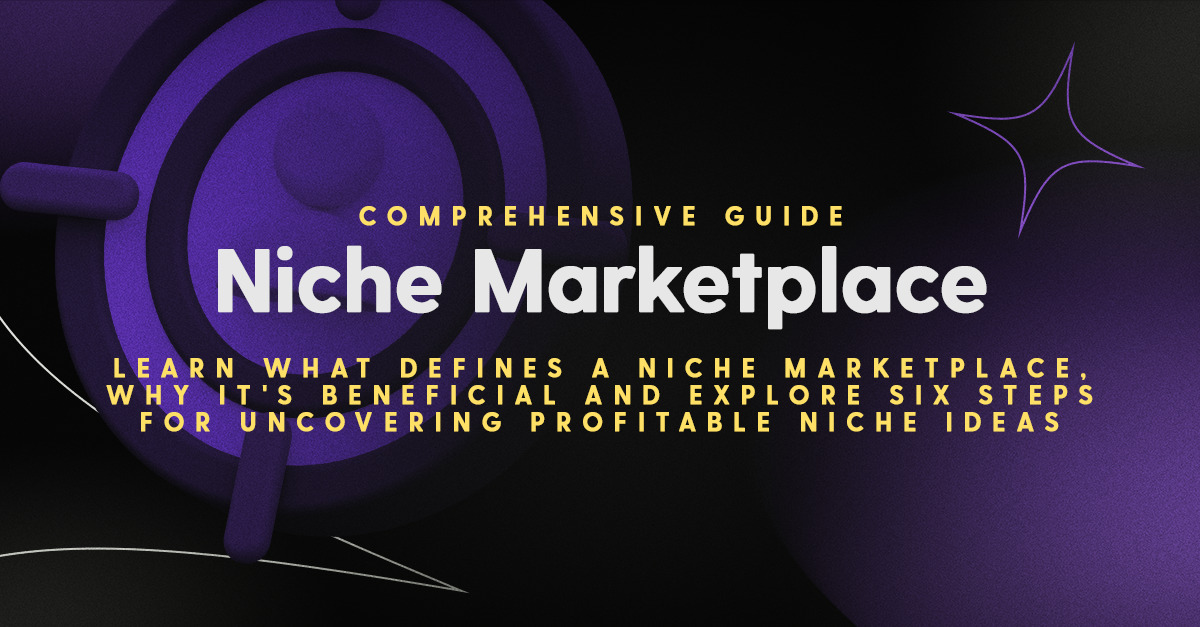Ever heard the saying “jack of all trades, master of none”? While general marketplaces like Amazon dominate in scale, niche marketplaces are winning in loyalty, profitability, and brand authority. Global marketplace trends for 2025 show that more entrepreneurs are choosing niche marketplace business models to target underserved audiences.
This is backed up by global marketplace research which shows a sharp increase in the numbers of online marketplaces that specilize in delivering niche products and services. Meanwhile, marketplaces like Rover, a unique marketplace for pet owners through to Chairish, a specilized marketplace for luxury furniture are generating millions in revenue by serving specialized communities with laser focus.
Whether you’re a solopreneur, startup founder, or looking for scalable side hustle ideas, building a profitable online niche marketplace has never been more achievable.
In this short guide, we show you how you too can find your niche and take advantage of new technologies to build your own niche marketplace.
What is a niche marketplace?
A niche marketplace is an online or peer to peer marketplace & two-sided platform that caters to a distinct segment of a wider market. This distinct segment is defined by its unique needs or characteristics.
It’s like looking at a large, diverse crowd and spotting a group that shares a common interest. Within the pet owners market, for example, there are niches for pet-owners who care about purchasing organic pet food. This niche caters to a unique set of requirements that don’t apply to the general market. Unlike general platforms, niche marketplaces specialize—giving you a unique advantage in SEO, customer retention, and monetization.
Let’s take a look a why it is a good idea to find a marketplace niche.
Why is it a good idea to find a marketplace niche?
Building a niche online marketplace gives you a sharper value proposition, lower competition, and a more engaged audience. To create a successful online marketplace, you need to carve out a niche. Choosing a niche helps you establish credibility with one audience and become the authority in a particular market segment. By doing this, you become the go-to business for a specific group of people.
Niching also:
- Helps you build brand loyalty. By developing content that connects on a deeper level with specific types of people, customers will choose your marketplace over a mass market company offering more products and services.
- Lowers marketing costs by allowing you to focus your target market on a specific, more targeted set of users. This approach reduces wasting resources on reaching uninterested or irrelevant individuals.
- Enhances customer satisfaction and retention by enabling you to better understand your unique customer requirements so that you can tailor your marketplace to meet their exact expectations.
- Increases your profitability through higher conversion rates and greater customer lifetime value.
Suppose you own a marketplace that connects suit tailors with customers seeking made-to-measure suits. One day you decide to allow sellers to offer mass produced t-shirts, footwear, hats and sunglasses to your marketplace.
Now, a seller is looking for somewhere to sell their made-to-measure services. Are they going to use your niche marketplace? Chances are, no. Furthermore, buyers looking for made-to-measure services will likely opt for a platform that specializes in made-to-measure services, rather than one that offers a mix of mass-produced clothing and accessories.
Say that instead, you position your made-to-measure marketplace as the #1 place to buy and sell made-to-measure suits. You focus hard on developing a solution where tailors can easily list their services and deliver buyers exactly what they want. You spend time and money hiring influencers to target suit tailors and their customers. Over time, you will become the go-to marketplace for made-to-measure suits and establish your place in the market.
Oh, and by the way, the men’s suit market is projected to grow to $20.2 billion by 2032. That’s not an insignificant number.
Want to launch faster? Tools like Dittofi’s marketplace builder make it easy to build a niche platform without coding—complete with templates for product, service, or rental marketplaces.
6 steps for finding niche marketplace ideas
Here’s your battle-tested, step-by-step system to uncovering a profitable niche idea in 2025.
The following 6 steps explain how to find niche marketplace ideas that work:
1. Evaluate your passion and skills
Finding your marketplace niche begins with working out what are your passions and skills. Ask yourself:
- What activities or subjects do you enjoy most?
- In what areas do you excel or have expertise?
- Where do your hobbies and strengths intersect?
These are all important factors when it comes to finding an idea for a niche marketplace.
Let’s say that you have a passion for the outdoors and are good at horseback riding. You may already have good connections to horseback riding professionals and enthusiasts in your local community.
In this instance, you might want to build a marketplace that combines your passion for the outdoors and horseback riding. For example you could build a marketplace for guided horseback rides, connecting horse riding enthusiasts with experienced guides and outfitters who offer scenic trails and adventures in your area.
The key is to find a marketplace niche that combines your passions with your skills. This will make finding and working in a niche marketplace much easier.
What are you good at? What are you passionate about?
2. Identify a few potential niche areas
Now that you have an idea of what your passions and skills are, it is time to start looking around for potential niche marketplace ideas. At this stage, you want to focus on building a long list of niche marketplace ideas so that you can determine demand. Later on you will narrow down these niche ideas.
Defining a niche involves identifying key characteristics of your potential buyers and sellers, which include:
- Demographic information (age, gender, income level)
- Geography (local, regional, national, global)
- Psychographic traits (values, attitudes, interests)
- Pain points and challenges (problems and pain points that your audience face in their real lives)
- Goals and aspirations
For example, a marketplace that sells horseback riding tours is a niche. Horseback riding is part of a much larger segment of outdoor adventure tourism and the audience is horse riding enthusiasts, outdoor enthusiasts, and travellers seeking unique and immersive experiences in nature, which have larger communities.
There is no one way to find a niche however, here are some paths that you can consider.
Start with Google searches
Google search is a great place to start brainstorming new ideas for a niche marketplace. For example, let’s say that we want to focus on the niche “Yoga”. We can start by typing in “Yoga classes for” and seeing what Google suggests.

As you can see, this gives us a goldmine of potential ideas such as a service based marketplace that focuses on yoga for seniors. Next, we can assess the level of competition in a particular niche by looking for websites that offer online yoga classes designed specifically for seniors.
Dig until you find an underserved problem that you feel you can provide a solution for. Keep in mind, even if you have competition, you can still compete by getting even more specific and building an effective marketing campaign. For example, the famous Airbnb marketplace was certainly not the first of its kind and it has many competitors today such as Vrbo which focuses on more spacious, family friendly properties.
Look around you for inspiration
Start thinking about the common pain points that you encounter everyday. These can come from your own experience as you look to solve problems in your own life.
For example, are you a skilled cook who struggles to find speciality ingredients for your recipes? A digital nomad disheartened by the lack of authentic workspace environments? A fitness enthusiast who struggles to find healthy meal options that fit into your daily life?
Take notice of any problems that you have and be the marketplace that serves that niche group of people.
Look for passionate communities
The internet allows for people to organize themselves into online communities around any shared passion. These passionate communities are niches. Look through active subreddits, look on Quora, subscribe to hashtags on Instagram or X, join online meetup groups.
Doing this you will find communities of passionate people. Within these communities there is potential to better serve each community with a niche marketplace idea.
3. Assess the market demand
When looking for a niche marketplace idea, it’s important to ensure that there is a big enough market to support it. It’s not a good idea to build a marketplace for a group of people that’s too small to sustain your business.
Here are a few ways to determine if your niche is big enough to support your marketplace niche:
- Total Addressable Market (TAM). This refers to the total revenue opportunity available for a product or service within a specific market. It represents the maximum potential sales that can be achieved if every possible customer purchased the product or service. In the case of a marketplace, you consider the combined revenue from both the buyers and sellers using the platform.
- Size of the niche market. This is the part of the total addressable market (TAM) that specifically matches your product or service. For example, if you’re selling organic pet food, your niche market would be the portion of pet owners interested in organic products within the overall pet food market.
- Growth rate of niche market. This is the rate at which the niche market is growing. For example, in the organic pet food niche, the growth rate indicates the rate of demand increase relative to the broader pet food market.
You can also plug your niche into Google Trends in order to research current trends. For example, below is an example that the topic “organic pet food” has had consistent demand over the past five years. This indicates that it is a promising niche to start a marketplace in.
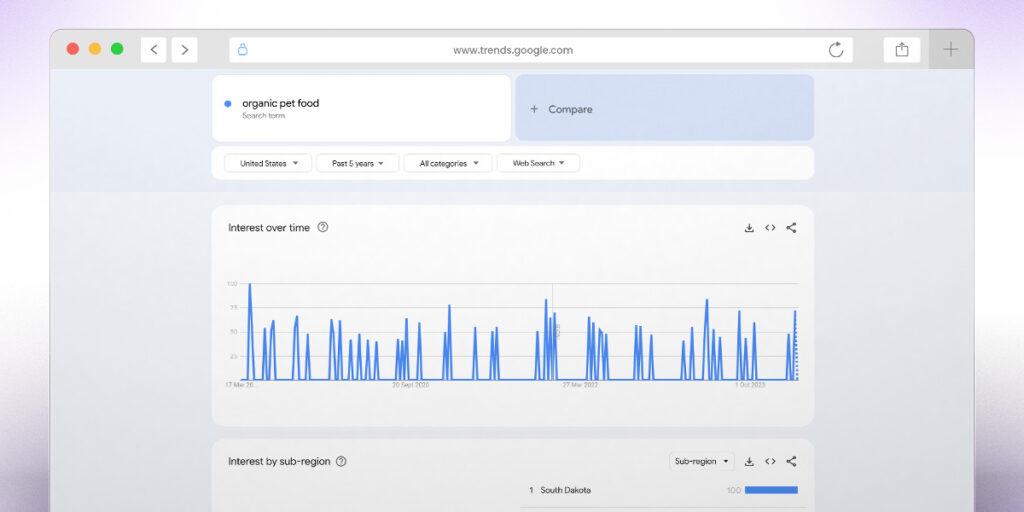
4. Narrow down to a specific niche
Now that you have a list of possible niches and have accessed the market demand, it’s time to narrow down your focus. Here are a few factors to consider:
- Are you passionate about the niche?
- Do you have personal or professional experience in that niche?
- Do you have existing connections in that niche?
- Are there any regulatory or legal barriers to entering the niche?
- What are the unique selling points of each niche?
Remember, although building a two sided marketplace can be incredibly lucrative, it is also hard. So first and foremost ask yourself, can you realistically see yourself running a marketplace in this niche area for the next 3 – 5 years.
5. Validate your niche
Once you’ve decided on a niche, the next step is to validate your niche marketplace idea. This will allow you to confirm the viability and potential of a chosen niche before investing too much time and money into your idea.
There are several steps that you can take to validate your marketplace idea.
Test your riskiest assumptions
The first step to validating your idea for a niche marketplace is to test your riskiest assumptions. To do this, you need to design and run a series of structured experiments. This involves the following steps:
- Complete a customer discovery process
- Write down your assumptions
- Design an experiment
- Run the experiment and measure the results
- Learn and grow
Step 1. Complete a customer discovery process
Customer discovery is the process of writing down who you think will be interested in using your niche marketplace. To do this, you should write a positioning statement that explains your company’s value proposition to both sides of the marketplace.
For example, I want to build a niche marketplace that connects pet owners with organic pet food providers. Therefore, I might write something like:
“A two sided marketplace that connects pet owners with organic pet food providers.”
Out of this positioning statement, I can then find my value proposition. In this example, my value proposition could be tailored to the benefits of providing a convenient platform for pet owners to access high-quality organic pet food options, while also offering organic pet food providers a targeted channel to reach their ideal customers. Additionally, emphasising the health benefits and sustainability aspects of organic pet food may further enhance the value proposition.
It may not be immediately obvious however, in both my positioning statement and my value proposition, I have made assumptions about the target buyers and sellers on my marketplace. Next up, we need to test these assumptions.
Step 2. Write down your assumptions
By writing down a positioning statement and value proposition, you now have a chance to uncover a range of assumptions that you are making about your target buyers, sellers and their need for a niche marketplace.
For example, in my positioning statement and value proposition, I have made the following assumptions about my target market.
Assumptions about pet owners (buyers):
- Pet owners are interested in purchasing organic pet food.
- Pet owners are willing to pay a premium for high-quality organic pet food.
- Pet owners are concerned about the health benefits and sustainability aspects of the pet food they purchase.
Assumptions about organic pet food providers (sellers):
- Organic pet food providers recognize the value of targeting pet owners interested in organic products.
- Organic pet food providers are willing to participate in a two-sided marketplace to reach their target customers.
- Organic pet food providers are capable of meeting the demand generated through the marketplace platform.
Once you have a list of assumptions written out for both your target buyers and sellers, the next step is to choose the riskiest assumption from your list and design a low cost experiment to test if this assumption is true or false.
If we prove the risky assumption to be false e.g. pet owners are concerned about the health benefits of the pet food they purchase, then we will need to pivot our business because it means that one of the central assumptions we need to hold true for our niche marketplace to work has failed.
In the next section, we will look at a low cost way to design this experiment.
Step 3. Design an experiment
One of the primary goals of an early stage marketplace is to maximize your runway i.e. the number of months you can afford to run your marketplace without being profitable. Therefore, you need to find the lowest cost way to test your riskiest assumption. This involves interacting with as many potential customers to find out if the assumption holds true or false.
There are lots of methods that you can use to run a low cost experiment. For example, you can set up a Facebook survey, create targeted landing pages, display targeted ads and so on.
At Dittofi, we have created a suite of marketplace technology and methodologies that you can use to validate your marketplace idea. An example of how to set up a landing page to test out a niche marketplace idea is shown below.
Step 4. Run the experiment and measure the results
After you’ve decided on a method to test your niche marketplace idea and set up your test, the next step is to run the experiment and measure the results.
The results will be either qualitative (non-numerical results e.g. written feedback) and quantitative results (numerical results e.g. how many people landed on your niche marketplace website clicked to sign up). There are many ways to collect up qualitative and quantitative results. For instance, you can use forms to collect written feedback or setup interviews with potential customers. Collecting up quantitative results could involve configuring Google Analytics on your website to track visitors vs the number of users who sign up.
Below is a short video showing how to set up Google Analytics on your Dittofi marketplace.
Before running your test, you should have an idea of what success looks like. Although not everyone who learns about your niche marketplace is going to immediately sign up, ask yourself, do you expect 10% of people visiting your landing page to sign up? Do you expect more than half the people you interview to give positive feedback? What is the measure of success you’re going to track?
Step 5. Learn and grow
The final step in idea validation is to learn and grow.
Based on your feedback from the previous step, you will either mark the experiment as successfully validating your riskiest assumption or failing to validate your assumption. If your assumption is validated, then you can move onto your next riskiest assumption or, if you invalidated your assumption, then it’s time to pivot.
If you need any help structuring your thoughts around idea validation, check out Dittofi’s idea validation board.
6. Build your niche marketplace MVP
Now that you’ve decided on a niche to focus on and validated that your niche marketplace idea resonates with both sides of your marketplace, the next step is to build an online marketplace MVP.
This will allow you to know if buyers and sellers are actually willing to sign up to your marketplace and what it is going to take to get them to transact on your marketplace. If people actually sign up and transact on your platform this is a good sign that you’ve found a viable niche.
Once you’ve found a viable niche, it’s time to invest in scaling up your marketplace and getting to profitability.
What are some examples of niche marketplaces
In this section we take a look at successful niche marketplace examples.
Reverb. A niche marketplace for musicians
As more and more musicians began using the internet to buy, sell and trade musical gear, Reverb capitalized on this trend by creating a dedicated platform specifically tailored towards musicians.
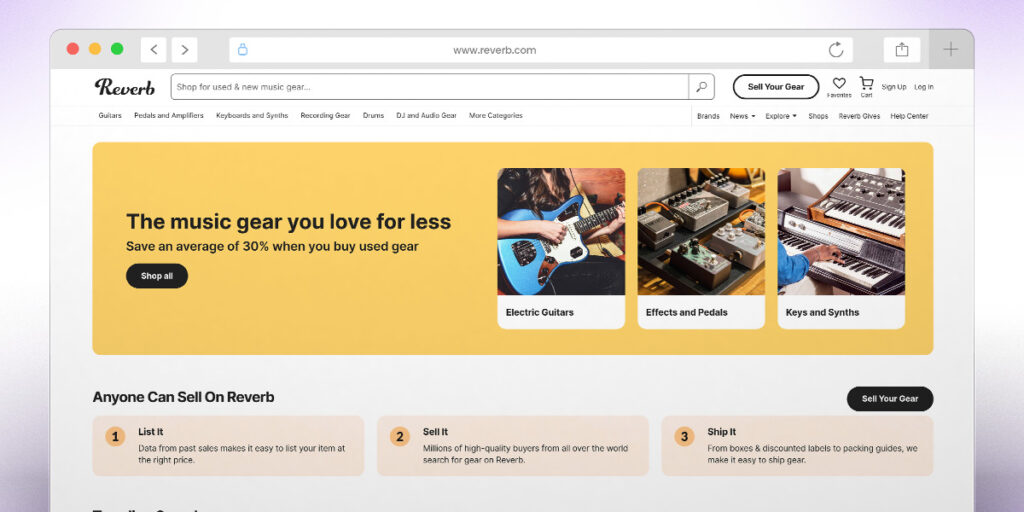
In order to stand out versus mass market competitors like Amazon, Reverb focused hard on their niche. To see an example of where Reverb adds value as a niche marketplace let’s take a look at the same product listed on both Amazon and Reverb.
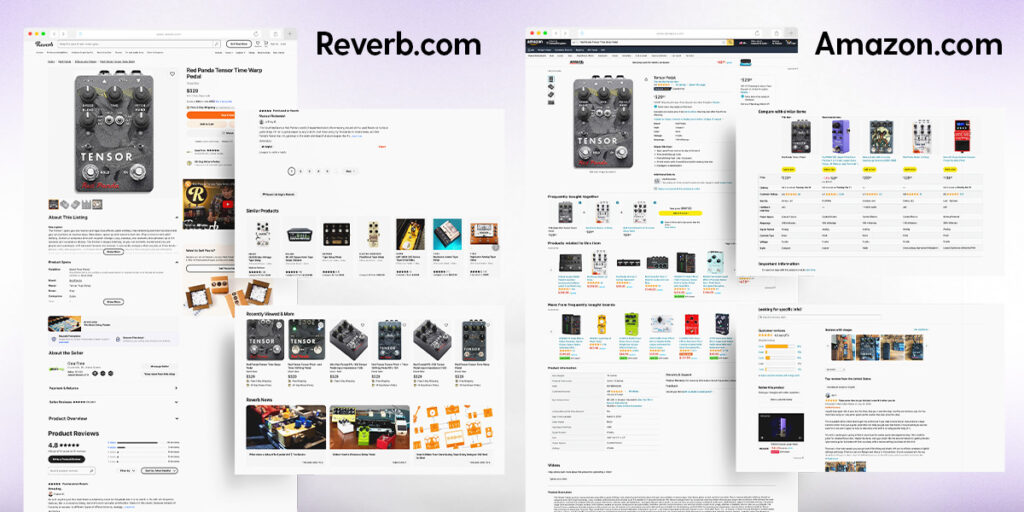
Looking closely at these pages, we can see that Amazon offers a standard listing while Reverb offers a more comprehensive approach. The Reverb page includes a detailed product description, reviews from fellow musical experts, and an informative video highlighting the top 5 guitar pedals of 2019, featuring the Red Panda Tensor pedal.
Notice that This video not only enhances the information available to potential buyers but also doubles up as marketing content that can be distributed on youtube and other social media platforms to attract interest for the Reverb target audience. Reverb also includes the option to contact the seller directly to ask about this pedal.
In 2019 Etsy acquired Reverb for $275 million cash. Not bad for the founders of this niche marketplace.
Rover.com. A niche marketplace for pet owners
Rover is a niche two sided marketplace that connects pet owners with pet sitters, dog walkers, and other pet care services.
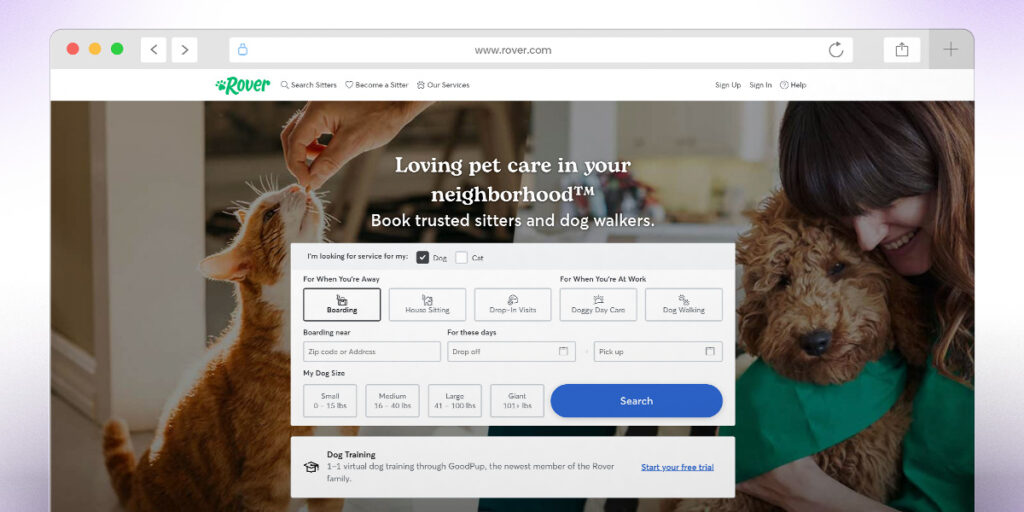
Founded in 2011, Rover has grown very fast. In 2022 Rover increased revenue to $174 million, a 58% increase from 2021.
The key to Rover’s niche marketplace success has been the ability to create a highly targeted marketing campaign has allowed Rover to become the authoritative source for pet care services, specifically in the realm of pet sitting, dog walking, and related services. For instance, you can Google for “Dog Boarding” and you will find Rover amongst the top ranked Search Engine Results Pages (SERPs).
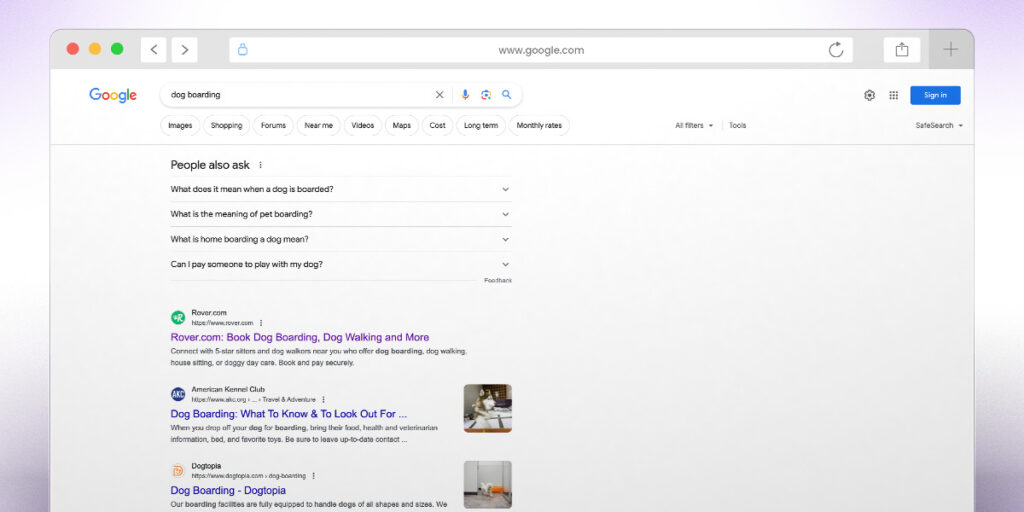
Boatsetter. A marketplace for boating enthusiasts
Boatsetter is a niche peer to peer boat rental marketplace that allows boat owners to rent out their boats to individuals looking for watercraft rentals.
Similar to platforms like Airbnb, Boatsetter connects boat owners with renters, enabling people to access a wide range of boats for various activities such as fishing, cruising, or water sports.
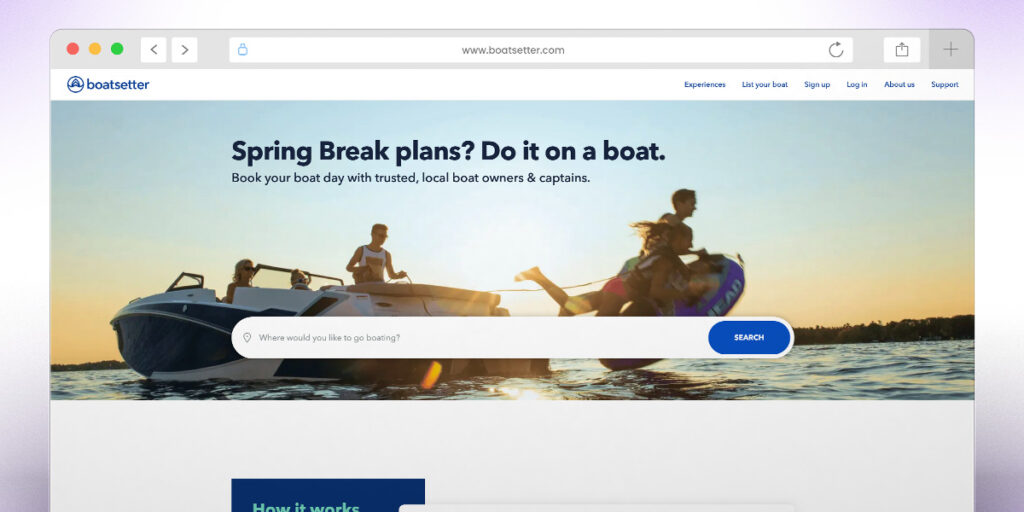
Boatsetter’s focus on a niche segment of the travel and leisure industry has allowed them to offer a superior user experience for boat owners and renters compared to the more generalized rental platforms. For example, Boatsetter offers specialist insurance coverage, safety training and customer support for boating activities.
Chairish. A marketplace for interior designers
A Global Data report forecasts that US home furnishings will surge from $415 billion in 2021 to $477 billion by 2027. Within this mass market, home furnishings resale reached $15 billion in 2021, and is projected to triple the industry growth rate by 2027, hitting $22 billion, primarily driven by online channels.
One online marketplace that saw this niche market and attempted to hitch a ride on this trend was Chairish, a niche online marketplace for buying and selling curated, luxury and pre-owned, decor and art.
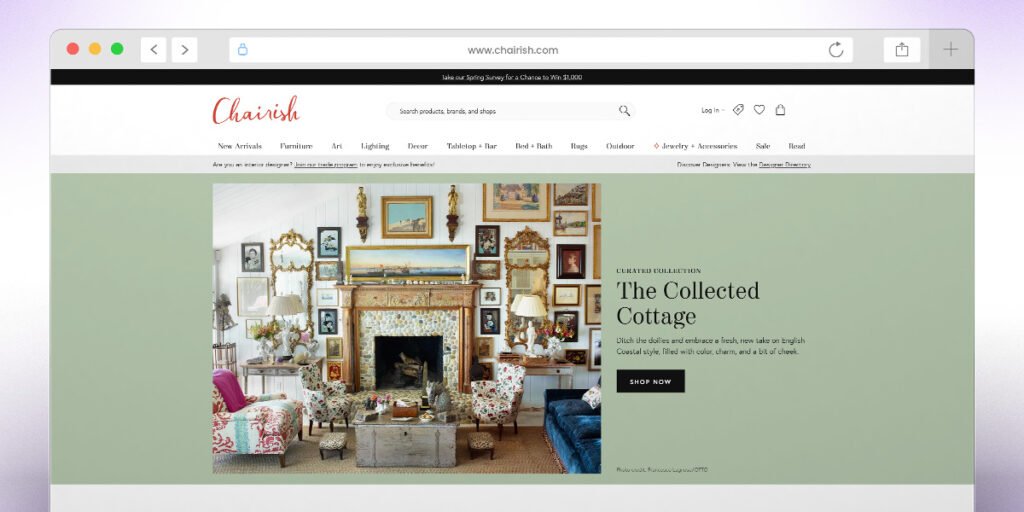
Chairish was founded in 2013 and, by focusing on a targeted niche they have been able to grow to more than $30 million in annual revenue, attracting more than $49 million in venture capital.
Chairish strategies to compete with mass market suppliers include, a focus on furniture resale, on quality through a meticulous curation process, targeted marketing campaigns and a “Buy Now Pay Later” program with Afterpay that was started in 2020.
Outschool. A marketplace for education.
Whilst the internet has transformed how our economy works, one area that has failed to keep pace with trends in digitization is the US education system. This stagnation is reflected in education outcomes and where less than 1 in 3 people living in the US feel like education is headed in the right direction.
The marketplace Outschool saw these challenges and developed a niche marketplace that focuses on delivering live online classes for children aged 3 – 18.
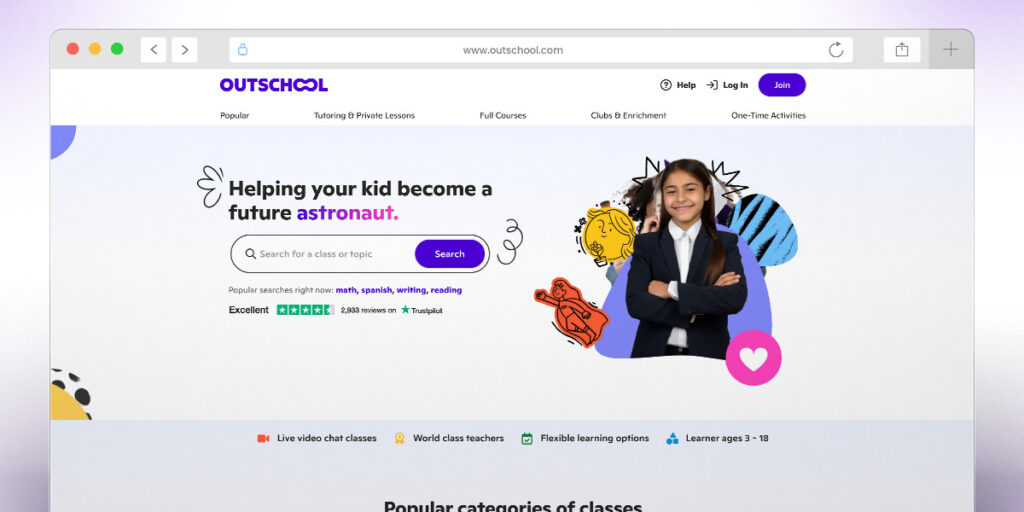
Outschool has a number of mass market competitors such as the Mass Open Online Course provides Khan Academy, Coursera, Udemy and so on. In spite of this competition, Outschool has been able to find a niche by focusing on live interactive classes with small groups of students, while Udemy offers a more traditional self-paced learning experience.
How to make your marketplace niche profitable
As we have seen, niche marketplaces have a distinct advantage in marketing to potential customers and persuading them to make purchases. However, you need to be sure that there are enough buyers in that niche to make it viable.
Getting to profitability involves a few strategic steps to capitalize on the unique elements of your audience:
- Focus on user experience. Unsurprisingly, delivering a quality experience to buyers and sellers who visit your niche marketplace is essential to getting profitable. A quality user experience will gain you new users via recommendations. Furthermore, a good experience will help encourage repeat transactions from loyal customers.
- Implement revenue generation strategies. There are various marketplace business models such as commission fees, subscription models, premium features and so on. Choose a model that aligns with your niche audience and offers value to both buyers and sellers. Experiment by changing the price charged to your buyers and sellers until you find a level that minimizes friction in the transaction and allows you to be profitable.
- Use paid and non-paid marketing channels. Find customers with a combination of targeted content distributed through a combination of social media and other paid channels and non-paid channels such as a targeted blog.
- Optimize and build a marketplace fly-wheel. Every marketplace must build a marketplace flywheel to be successful. A marketplace flywheel is a set of steps that lead to a self-reinforcing cycle of growth. For example, imagine a niche marketplace like Rover. As more pet owners (demand) join, the demand for pet sitters (supply) increases, this attracts more sellers which in turn draws in even more users. This creates a self-reinforcing cycle where the platform grows stronger with each new pet owner or pet sitter, known as network effects.
Conclusion: Build a niche marketplace today with Dittofi
In 2025 and beyond, the smartest founders aren’t trying to build the next Amazon.
They’re building niche marketplaces that solve specific problems for specific communities — faster, better, and with more love.
Whilst it is used to cost $50,000 – $200,000 just to build an MVP for your niche marketplace idea, marketplace technology and no code marketplace builders such a Dittofi can be used to help you build a niche marketplace in less than 24 hours.
For more information on how to build a niche marketplace fast on Dittofi, read:
- How to build a product marketplace on Dittofi. Fast.
- How to build a service marketplace on Dittofi. Fast.
- How to build a rental marketplace on Dittofi. Fast.
Become a Marketplace Insider
Join our inner circle for exclusive insights, coveted trade secrets, and unparalleled strategies – your journey to marketplace dominance begins here.

